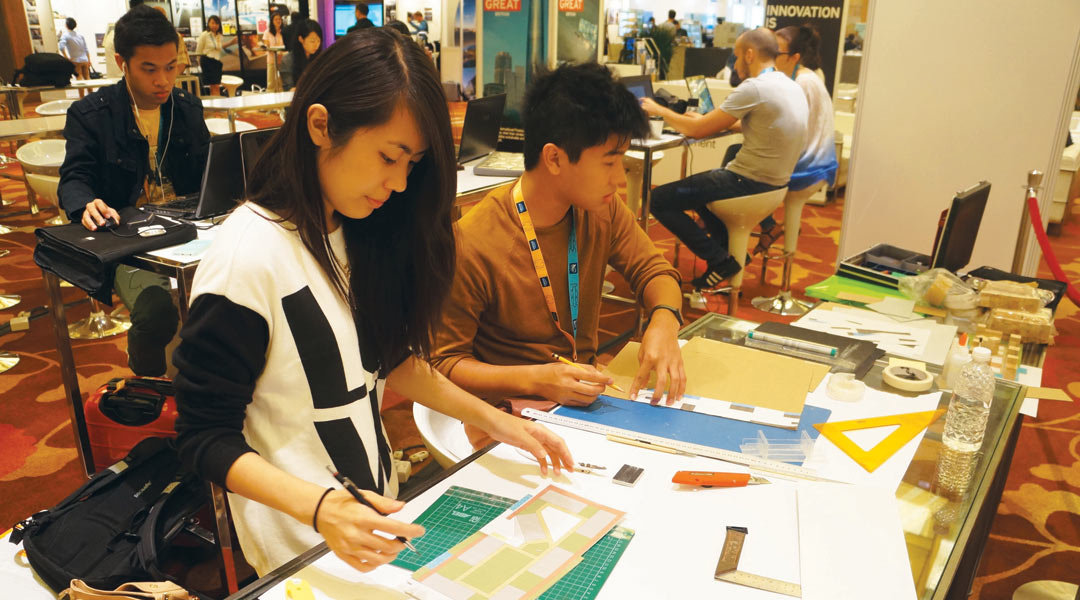
WAF has a student competition that the PH already won
Some 2,000 architects and designers from over 60 countries gather at the World Architecture Festival (WAF) to exchange thoughts on new ideas, technologies, techniques and current issues facing architects and design professionals. While most people goes for the talks, the high point of course, is the cocktails and gala dinner when the winners of the WAF Building of the Year, Future Project of the Year, Landscape of the Year, and WAF Student Competition are announced.
For the Filipinos attending the 2013 festival held in Singapore, the undisputable and unforgettable highlight was when four Filipino students from the University of San Carlos – Cebu were called to the stage to accept their award as winners of the WAF Student Competition: Jon Adriel Go Medalla, Miguel Jorge Rocha, Kathleen Canlas and Keshia Stephanie Lim.
Out of almost 50 student teams that submitted entries, six in addition to the Philippines were shortlisted to compete in the final round of the competition: Italy, Russia, Bulgaria, Vietnam, Singapore, and India. The University of San Carlos students are the first Asian team to win the WAF. Previous winners have been from prestigious schools in the US and Europe.
Upon the invitation of the Singapore Tourism Board, I was extremely fortunate to have been at the gala to see the four kids go up onstage, and afterwards, to share the extraordinary moment with the team and their chaperones—architects and mentors Alex Medalla (Jon’s dad) and Buck Sia (the students’ professor at USC); Bro. Bela Lanyi, the chairman of USC’s Architecture Department; and Janet Medalla, Jon’s mom and Alex’s partner in their firm, Arkinamix. Upon our return home, I interviewed them and as well as architects Jason and Nikki Buensalido, who watched the students’ presentation.

The Festival
BluPrint: Why is the WAF significant?
ALEX MEDALLA: The experience is always invaluable. The WAF and the Biennale are among the really few times one can experience an assemblage of international architects who you really look up to, with whom you can mingle and ask questions of. That’s the bonus. The festival is a condensation of talks, ‘crits,’ exhibits and various other presentations that are important, because the exposure adds to the knowledge of an architect.
NIKKI BUENSALIDO: We heard about the WAF from architects Alex Medalla and Buck Sia. Jason and I, along with our associate architect, Ems Eliseo, represented Buensalido Architects. The festival venue was at the gargantuan Marina Bay Sands Convention Center, where exhibits, fora and project critiques took place simultaneously in different halls and function rooms. We had to plan our schedule carefully, as we wanted to attend the talks and design ‘crits’ relevant to our practice. During the three-day event, we were able to sit down and listen to close to 70 speakers, many of whom were finalists presenting their projects entered in the WAF’s Building of the Year design competition!
The finalists included Zaha Hadid’s cultural center in Azerbaijan, and Tadao Ando’s school of architecture in Monterrey, Mexico. We listened to Sou Fujimoto on his approach to urbanism and architecture in Japan; to Charles Jencks and Deitmar Eberle on the values and purpose of architecture; and to project presentations of 3XN Studio’s Kim Herforth Nilsen, who spoke on valuing and quantifying delight in architecture.
The experience was enriching and exhilarating—an information overload of new ideas, perspectives and approaches to responding with contextual architectural solutions. At the end of the festival, we were overflowing with new design ideas and excited to apply what we learned to our craft!
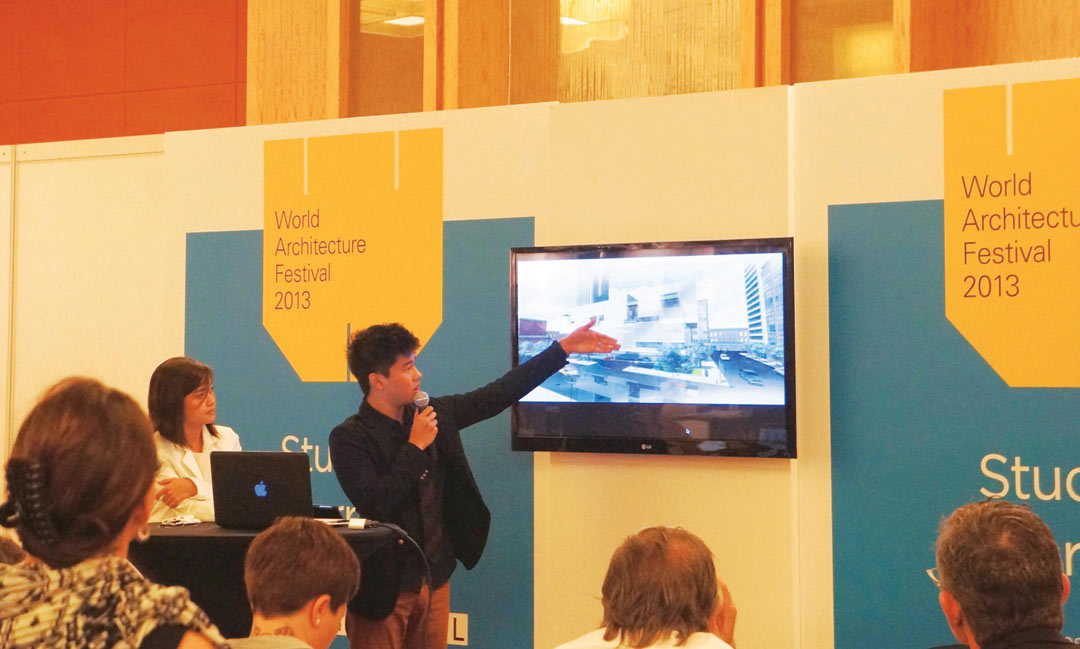
The Student Competition
Did your dad tell you to join?
JON MEDALLA: Sir Buck and my dad mentioned that there was some sort of student competition going on during the festival. I didn’t initially think of joining, but last March, while thinking of ways to do something productive for my summer break, it suddenly dawned upon me that joining the WAF student competition would be a great idea!
JANET MEDALLA: When Jon told us he was going to join, we were not so sure it would be a good idea. Not because we didn’t have faith in what he can do, but because he was just a sophomore then, and we were thinking it would be a bit too early because he would be up against students of higher levels and with more experience. We didn’t encourage him nor did we discourage him but we just let him be.
What was the challenge and what were the requirements?
JON: The question posed to us was, “How can architecture respond to our changing modern society, in which people are living longer than before and traditional family structures are beginning to change?” The WAF website suggested particular issues that we could address, such as: how to restore a sense of neighborhood in public spaces; keep people fit and active, and perhaps even mitigate conditions such as Alzheimer’s disease and dementia; and make housing more flexible so as to accommodate a family in flux, where the older generation can comfortably dwell with the younger generation, and vice versa.
How did the team get together?
JON: After deciding that joining would be a good idea, I called my girlfriend, Kathleen (4th year), and my good friends Keshia (4th year), and Jorge (5th year)—all three the best in their respective year levels—and that’s how our team was formed.
How long did you have to prepare?
JON: In total, we had two weeks to create the whole proposal from scratch! The reason for this was that the deadline was somewhere in the middle of April, and both Jorge and I had already planned trips abroad with our families. When we both got back in early April, two weeks was all the time we had left to create the proposal. We worked every single day of those two weeks, including Sundays!
Describe the process. What were some of the challenges?
JON: We consulted Sir Buck and my dad to get their opinions on certain things. The process was initially very gradual and the ideas came little by little, but as we built up momentum, the solutions came faster and became clearer. The first half of Week One was dedicated to conceptualization, while the rest of the time was dedicated to execution and presentation. The biggest challenge was coming up with the initial concept. It was tough, because the task given to us was not to design a particular building with a designated program. The requirements were not concrete but very ambiguous.
BUCK SIA: Before they started on the project, I told them to really focus on the issue before going into form finding, that they were designing systems, not products. It was back and forth, critiquing them and challenging them to think further. One thing I encouraged them to do was a diagrammatic presentation, showing step by step how the design came to be.
How did you decide on concept? What were each member’s contributions?
JON: The concept was the hardest part! We initially did not have an idea of what we were going to do. The final proposal was really the result of a long process of developing and re-developing certain ideas. It was a collaborative effort. I contributed to the design development of the building, the lobby design, research, diagram making, conceptualization, script writing, and physical and digital modeling. Kat designed the landscape, worked with Keshia to design the units, helped with the diagrams and conceptualization, and did the bulk of the presentation work, and was the reason why the presentation slides ended up so beautifully designed. Keshia did most of the CAD drawing, planning, designed the units with Kat, helped with the diagrams and presentation work, and edited the presentation video. It was Jorge who proposed using a perforated skin. He did digital modeling, helped Keshia and Kat with the design of the units, did the structural components, and was in charge of one of our secret weapons—the presentation video.
JANET: During the two weeks he and his friends were working on their entry, we had guests in the house so I didn’t really get much chance to take a look at what they were doing. They worked everyday in the house until the day before they were to submit their entry. When I finished going through their presentation slides, the first thing I said was, “You guys have a shot at this!”
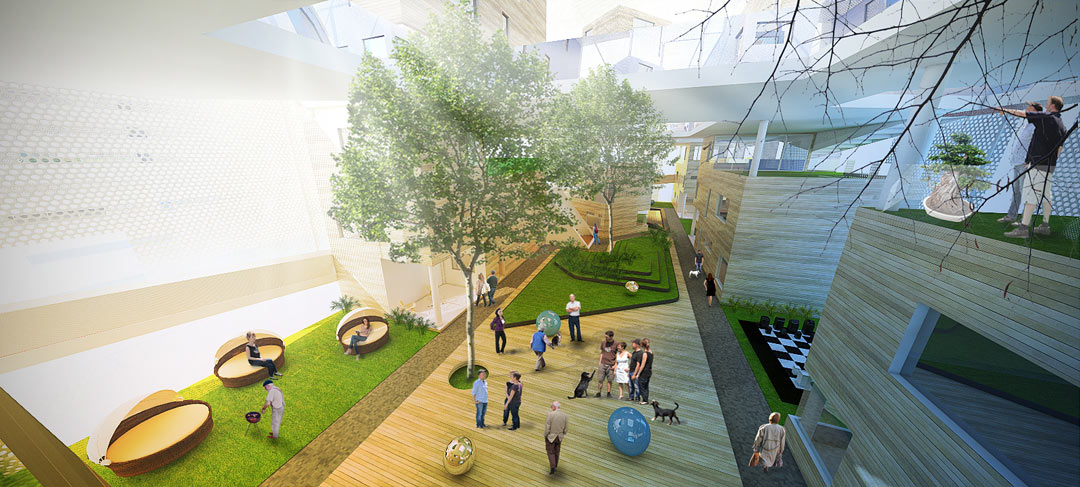
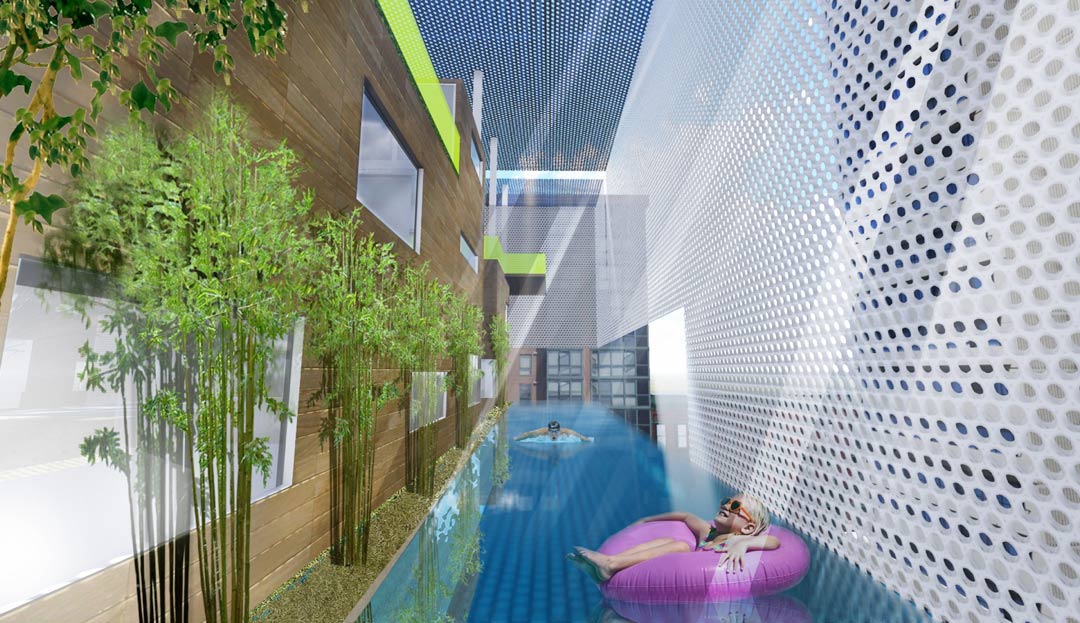
The Village in a Box
Tell us about the concept and supporting arguments.
JON: In the Philippines, particularly in Cebu, recent economic growth has seen an increase in the Filipino middle class, and an increase in urban density and the surge of condo developments. However, the local condo typology caters to singles and small families, making condos and similar dense residential developments unappealing to the traditional Filipino family, where it is very common to see three generations living under one roof. In general, Filipinos are more comfortable in a village-like setup that fosters social interaction, rather than the impersonal condo setup.
JASON BUENSALIDO: After establishing our culture in the Philippines, they discussed their findings on Alzheimer’s disease, that majority of those who suffer from Alzheimer’s spend their elderly years solitarily or in a home for the aged. Then, they showed statistics demonstrating that amongst the elderly who spend their latter years with their families, there are dramatically less cases of Alzheimer’s. Jon cited statistics showing that the Philippines has one of the lowest rates of Alzheimer’s Disease in the world, and he attributed this to the great majority of Filipinos living in multi-generational households.
JON: We then asked ourselves, how can these values survive given the current state of urban development? Is there a compromise that preserves the atmosphere of a village in a dense urban development? Our solution: the Village in a Box.
JASON: It was a multiple-dwelling complex that allows the elderly not only to live with their families, but also to interact with each other on a daily basis. They achieved this by providing abundant urban spaces that allow chance meetings to occur, and different physical activities to be introduced such as swimming, walking, yoga, etc., enhancing the daily lives of those who will reside in the space.
JON: Each unit is designed to be multi-provisional, and to expand and contract in response to the evolving needs of the family.
Getting Shortlisted
Let’s backtrack. How did you find out you were shortlisted? Were you asked to submit more requirements?
JON: We found out through an email sent to us by WAF last July. The additional requirements were given to us when we arrived in Singapore.
How did you prepare for the presentation?
JON: Bro. Bela Lanyi, the chairman of our Architectural Department in USC, who also accompanied us to Singapore, allowed us to skip our last design project for the semester in order to give us time to prepare. We used this time to refine our design, plan for contingencies, and practice our presentation. We presented the proposal in front of our school, and to be asked questions by a panel as a ‘dress rehearsal’ for the actual event.
Describe the actual event.
JON: First, when we got to Singapore, we were given an additional requirement: to incorporate into our initial proposal a water feature promoting well-being and fitness. We were given two days to work on it, in one of the open exhibition halls, where delegates and judges could freely roam to watch.
BUCK: Seeing the other teams, they were quite intimidated because the others were using advanced software—it was like David versus Goliath, Sketchup versus Grasshopper. I reminded them their idea was very strong and to capitalize on that. As for Alex and I, we would go watch the talks and drop in on them to check on their progress. We wanted the students to really figure it out by themselves. The second day was spent making additional presentations boards and renderings for the revised scheme. They were so determined they insisted on having a detachable scale model.
JON: On the third day, the seven teams presented. We were second to present. The set-up was sort of like an architectural American Idol where the judges were seated at a table in front of us. The judges were Michael Heenan (Allen Jack+Cottier, Australia), Murray Fraser (Bartlett School of Architecture/UK), Ralph Johnson (Perkins+Will, USA), and Mille Sylvest (GXN, Denmark). Lots of people were watching—delegates and the other students.
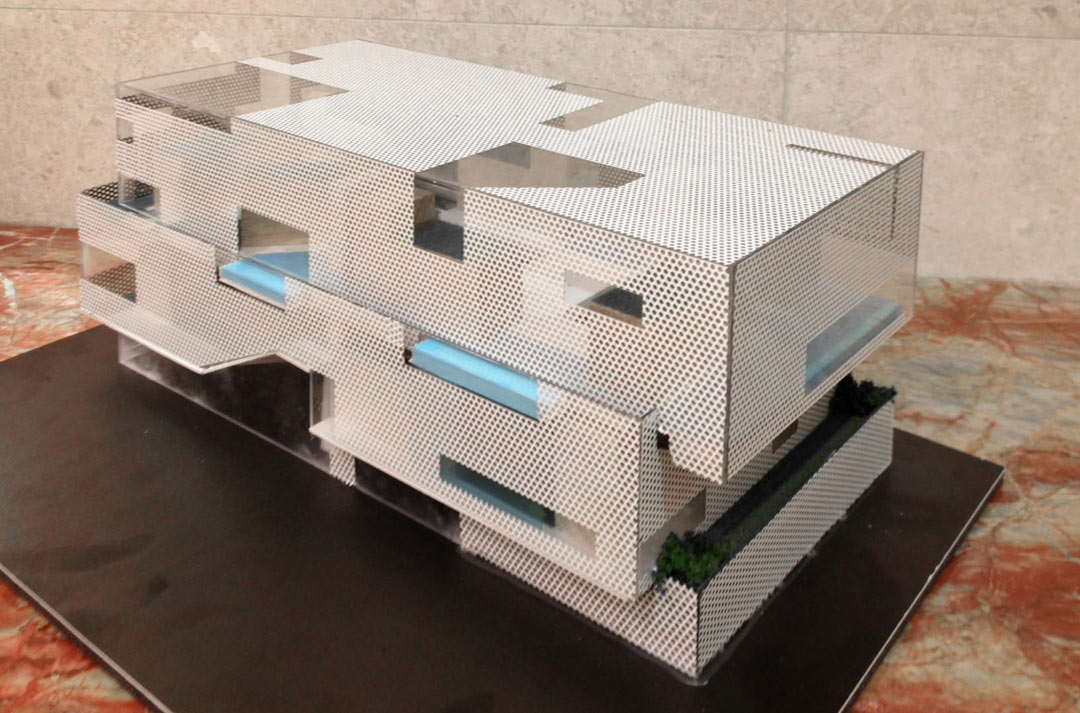
The Presentation
How long did it take?
JON: The ordeal lasted around 30 minutes. 15 minutes for the presentation and 15 for the Q&A.
How did the kids do during presentation?
NIKKI: Extraordinarily well. Jon, Miguel, Kathleen and Keisha came up with really good material, and they did not have a hard time explaining the concepts. They stuck to their thesis and their beliefs, defending our culture and why they designed the spaces that way. Jon presented, and Kathleen helped Jon answer questions. The rest of the team showed the models to the judges, and were at attention in case Jon needed assistance. Jon started off a bit nervous, but after the first few introductory sentences, he was on a roll. We knew that the team was very tired but they didn’t show it during the defense. It was as if every ounce of adrenaline was gushing through everyone’s veins, including ours, as we willed them to deliver their ideas perfectly.
Watching them reminded Jason of his gut-wrenching experience defending his team’s entry to the CCP Competition. Jason faced Filipino judges but these kids were defending their design before architects from different parts of the world! Also, some of the other students were already in graduate school, but the kids on the Philippine team were all undergraduates! What a feat!
Jon was also very polite. He’d thank the panel every time they asked a question. The judges at times had difficulty grasping the idea of how Filipinos live with their parents, grandparents and helpers. Jon and his team were gracious in explaining local customs and practices, but at the same time were very smart in always referring to the model and how it responded architecturally to the challenge.
How did Alex and Buck fare in the meantime?
NIKKI: Alex and Buck were probably more nervous. They looked like coaches watching a very intense basketball game!
BUCK: Oh, yes, I was quite nervous for them! But I was confident they would explain the concept thoroughly. The judges threw them a lot of questions, which the kids answered well, using the numerous diagrams and prepared floor plans. When it was over, one of the judges commented: “Congratulations, you just may have created a new typology!” That was the icing on the cake!
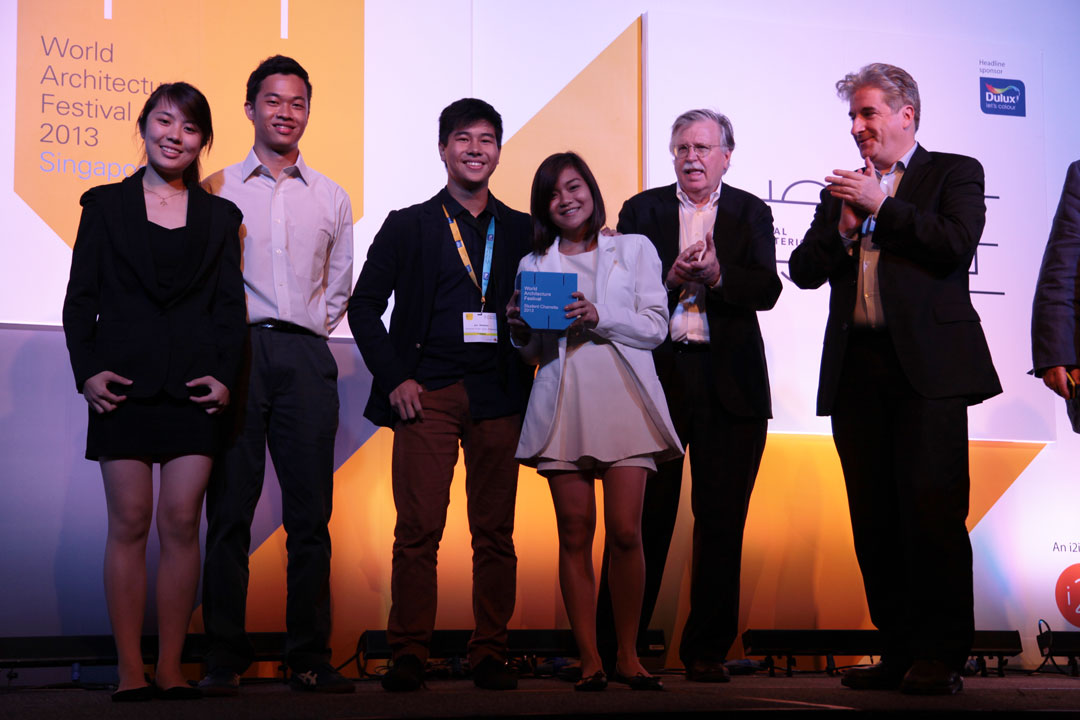
Winning
BUCK: I believe they won because there was a clear connection from the statement of the problem to the research, to the idea, then to the architectural solution, which was really well thought through, integrating great function and form. The presentation, walk-through animation and the model, which helped the judges appreciate and understand the intent of the space, really impressed them.
JANET: The thought process that brought about the final design was solid. They identified the possible link of loneliness to Alzheimer’s and dementia, and they addressed this architecturally by integrating social spaces with the main circulation spaces of their proposed development. I think this was the factor that made them win.
Another factor would be their work ethic. They went to the competition well prepared—they brought everything they thought they would need, including a printer and a video projector, because they were told that only paper and pencils would be provided, and that if they wanted to present electronically, they would have to bring their own equipment!
Most importantly, there was great teamwork in their group. Let me elaborate. The original intention was for all four of them to speak during their presentation. But after their practice presentation in school, which lasted 45 minutes, they all agreed that too many speakers would take up much time and the flow of presentation wouldn’t be as smooth. So it was decided that Jon and Keshia would be the presenters. The day before final presentation, Keshia volunteered to let Kathleen take her place because she had a cough and cold during the entire trip, and she didn’t want to risk messing up the presentation. This is what I admire most about the group. Each was willing to not only give their best, but also to set aside personal glory for the good of all.
Final Thoughts
What was the memorable highlight of this experience?
JON: The whole thing! Never in my wildest dreams would I have imagined that I would be doing design development on-the-spot, and presenting our design in front of architects from all over the world. The whole experience when by in a blur and was quite surreal. It was as if all the training I had received in my journey as an architecture student culminated in those three days. It was surely an experience I will treasure with me my whole life.
BUCK: It was great witnessing the distinguished architects and audience of the gala congratulating and clapping their hands on the win. At the end of the gala, all Alex and I could do was enjoy a nice silent moment and a sigh. This is mentoring and cultivating culture at its best; being part of inspiring others to create architecture with meaning. Alex mentored me, and provided me with a strong architectural foundation. I try very hard to pay this forward for future generations.
NIKKI: We heard the news from Buck. We were all ecstatic and so, so, so proud! We watched the actual announcement of the judges via Buck’s and Jon’s Facebook page, and we were beaming with pride. The first competitive entry to the WAF from the Philippines came not from practicing architects but students! There is a future for Modern Philippine architecture!
What has this experience taught you?
JON: It reinforced my belief in the importance of the idea behind architecture. The other teams may have had more sophisticated software and superior rendering skills, but in the end, I believe it was our focus in cultivating the ideas behind our project and our ability in making those ideas readily understandable and relatable that won the day. But perhaps the greatest lesson this whole experience has taught me was that it is okay to dream big and aim high, because with hard work, creative thinking and the help of great friends, family and mentors, it can happen.
ALEX: For us, it strengthens our conviction even further to create a culture of passion and excellence for the craft, and the rest will just fall into place. For them, winning a competition of this magnitude will never be forgotten. It is one thing to join a national competition and another thing to join an international one—that takes a lot of courage and guts coming from a position of no track record whatsoever, as an individual, school or even the country. And I think it is courage that made all the difference. Joining the competition and winning it basically proved one thing—these kids are at par with the international student community. But they would never have known this had they not had the audacity to try. ![]()


